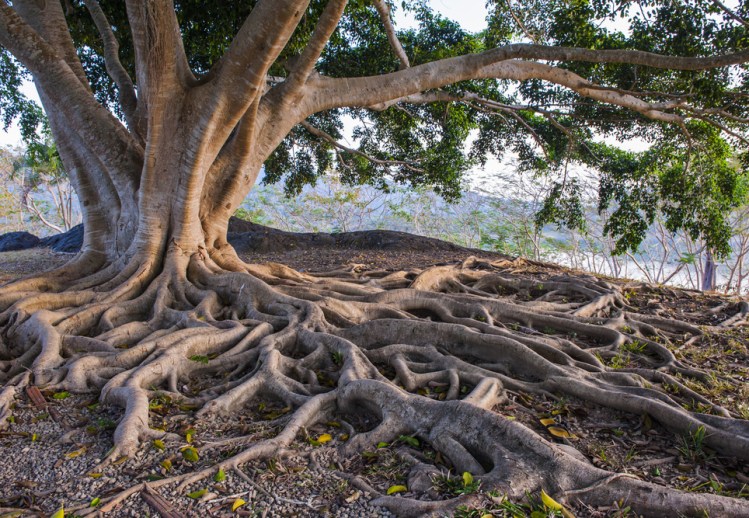“If you could spend, as I did, the sweeter part of four good years in that forest, scanning a sea of treetops for a twist of smoke, walking beneath that canopy of leaves in the chill clear mornings and again in the evenings … you too might begin to wonder, not only about yourself but also about these beings, alive, sentient, transpiring, which surround you.… What they felt I had no notion of.… But their conscious presence was unmistakable. I was not alone.”
– Edward Abbey, “The Crooked Wood” in “The Journey Home”
Biologist David George Haskell illuminates that unmistakable conscious presence in his lyrical new book, “The Songs of Trees: Stories from Nature’s Great Connectors.” He shares his extended experiences with 12 trees around the globe, portraying them not as individuals but as “pluralities,” embodied networks continually negotiating between conflict and cooperation. Paying attention to trees, he writes, helps us remember that “we too are nature. Unsunderable.”
Haskell brings to his forest explorations an unusual sensibility, fusing scientific expertise with a poetic ear and the focused awareness of a longtime practitioner of meditation. Yet he is no New Age guru, extolling the unity of all being. “The struggle is indeed intense,” he acknowledges, “but instead of separating life into atoms, the Darwinian war has created a furnace that burns away the individual, melting barriers and welding networks as strong as they are diverse.”
The scope and complexity of the vast network underlying forests escapes the notice of many people – who grow up with a stick-figure view of trees and see in soil just dirt.
Even when trees topple, like those in this fall’s powerful windstorm, only the reach of their roots is revealed, not the symbiotic association of mycelium fungi, those fine white threads evident in forest soils. “A mere teaspoonful contains many miles of fungal filaments,” and a single oak tree can harbor more than 100 fungal species, observes forester Peter Wohlleben, author of the 2015 book “The Hidden Life of Trees,” another eye-opening exploration of how trees communicate and cooperate.
 Up to half of a forest’s biomass can be found in this underground network of bacteria and fungi, which vastly extends a tree’s capacity to access nutrients and water. “You can find twice the amount of life-giving nitrogen and phosphorus in plants that cooperate with fungal partners,” Wohlleben notes, compared to “plants that tap the soil with their roots alone.” In return for their efforts, the fungi receive sugars derived from trees’ photosynthesis.
Up to half of a forest’s biomass can be found in this underground network of bacteria and fungi, which vastly extends a tree’s capacity to access nutrients and water. “You can find twice the amount of life-giving nitrogen and phosphorus in plants that cooperate with fungal partners,” Wohlleben notes, compared to “plants that tap the soil with their roots alone.” In return for their efforts, the fungi receive sugars derived from trees’ photosynthesis.
The subterranean network that ecologist Suzanne Simard has dubbed the “wood wide web” enables a degree of sentience that few people yet acknowledge.
“Even though (a tree) lacks a nervous system,” Haskell observes, “the tree’s cells are awash in hormones, proteins and signaling molecules whose coordination allows the plant to sense and respond to its surroundings.” Every tree, he affirms, “integrates, weighs and judges the world in a manner that combines external and internal intelligence.”
While we readily credit other animals with thought and memory, we have greater difficulty grasping how forests think. Trees lack centralized brains; their intelligence is suffused throughout their bodies and the living networks that sustain them. “The diverse nature of these relationships,” Haskell writes, “means that the tempo, texture and mode of the forest’s thoughts are quite different from our own.”
The tempo of forest communications is slow, shaped by trees’ deliberate growth and often their great longevity. Trees’ signals move roughly 20,000 times more slowly than nerve impulses travel within humans, taking a minute or more to span the length of one leaf.
The exchanges go well beyond a chemical or mechanical transfer of resources. Haskell likens a forest soil network to a street market: “Roots gather to exchange food and in doing so they also hear the neighborhood news.” The trees are remarkably responsive to perceived needs – warning others of insect predation, nurturing younger seedlings and sharing nutrients with an ailing neighbor. The exchanges are not confined to kindred tree species; even plants that compete, it turns out, cooperate.
The connecting role that trees play extends to our own species, Haskell affirms, depicting the deep bonds that people have to particular forests and trees. That spiritual link can act as a salve, he suggests, healing a centuries-old mental divide separating humans from the rest of the natural world. Trees help us envision a more encompassing sense of belonging.
“The Songs of Trees” reminds us that ecology is not simply a science. It is the art of being at home in the world, rooted in a community. Sentient beings surround us. We are not alone.
Marina Schauffler provides research, writing and editing services to nonprofit and social enterprise organizations through Natural Choices.
Send questions/comments to the editors.



Comments are no longer available on this story